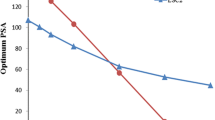Abstract
A comparison of the attainable characteristic physical data for whole-body radioactivity detectors (high-pressure ionization chambers, NaI crystals, and liquid organic scintillators) shows that the only advantage of NaI-crystal detectors is better energy resolution. For all other criteria (optimal counting geometry, reproducibility of the counting geometry, overall efficiency, sample volume size, minimum detectable radioactivity, and required minimum counting time) the whole-body radioactivity detector with liquid organic scintillators is superior to all other large-volume detectors.
Presented at the Sixth Symposium on Advances in Tracer Methodology, November, 1962.
Access this chapter
Tax calculation will be finalised at checkout
Purchases are for personal use only
Preview
Unable to display preview. Download preview PDF.
Similar content being viewed by others
References
Van Dilla and Anderson, in: Whole-Body Counting, Proc. I.A.E.A. Symposium, Vienna (1962), pp. 41–58.
Heinrich, Proc. 1960 University of New Mexico Conference on Organic Scintillation Detectors, U.S.A.E.C., Washington, D. C. (1960), pp. 312–328.
Heinrich, Proc. Second Symposium on Radioactivity in Man—Applications of Whole-Body Counting, Northwestern University Medical School, Chicago, Ill., Sept. 5–7, 1962 (in press).
Heinrich and Pfau, Atomkernenergie 6: 463 (1961).
Heinrich and Gabbe, in: Proc. Second European Symposium on Vitamin B12 and Intrinsic Factor, Enke, Stuttgart (1962), pp. 638–663.
Heinrich and Gabbe, in: Conference on Vitamin B12 Coenzymes, April 10–11, 1963, Ann. N. Y. Acad. Sci. 112:871 (1964).
Lushbaugh, Hearings of the Joint Committee on Atomic Energy, U.S. Congress, Washington, D. C. (1961), pp. 27ff.
Heinrich, 42 Deutscher Röntgenkongress, Nr. 27, Hamburg, April 16–19, 1961, Proc. Strahlenforschung und Strahlenbehandlung, Vol. III, Urban-Schwarzenberg, München (1961), pp. 198–205.
Heinrick and Gabbe, in: Proc. Second European Symposium on Vitamin B12 and Intrinsic Factor, Enke, Stuttgart (1962), pp. 252–275.
Author information
Authors and Affiliations
Editor information
Editors and Affiliations
Rights and permissions
Copyright information
© 1965 New England Nuclear Corporation
About this chapter
Cite this chapter
Heinrich, H.C. (1965). Clinical Use of Liquid-Type Whole-Body Radioactivity Detectors. In: Rothchild, S. (eds) Advances in Tracer Methodology. Springer, New York, NY. https://doi.org/10.1007/978-1-4684-8622-3_31
Download citation
DOI: https://doi.org/10.1007/978-1-4684-8622-3_31
Publisher Name: Springer, New York, NY
Print ISBN: 978-1-4684-8624-7
Online ISBN: 978-1-4684-8622-3
eBook Packages: Springer Book Archive




